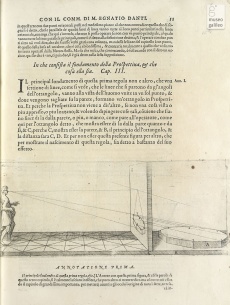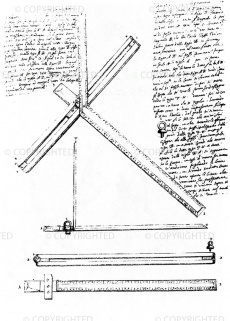Square by Egnazio Danti
From Inventions
Name adopted by the inventor.
Contents |
Inventor
Egnazio Danti (1536-1586)
Historic Period
ca. 1570
Description
Perspective instrument designed by Egnazio Danti, perhaps while employed as teacher at the Accademia delle Arti del Disegno. It is a graduated square sliding along a guide placed on the margin of the sheet of drawing paper. The painter’s viewing point is replaced by a hook in the wall as in Albrecht Dürer’s window, and the visual ray is represented by a string stretched taught between the hook and a point on the object to be drawn. The vertical arm of the square serves to intersect the “visual” string, while the horizontal one, thanks to the graduated scale, is used to transcribe the intersection point onto the drawing paper. The image observed is basically overturned on the horizontal plane. Danti proposes this instrument as a variant of Dürer’s window: "Add to the above-mentioned windows, this one reduced to the form of rules, which I once fabricated in this way in Florence. I used three rules, each four palms long …But I divided them into 40 parts each, and used them in such a way that, at point C, they were attached together to form a square..." Some variants of the instrument appear in manuscripts from the Veneto area that were owned by Giacomo Contarini and Gian Vincenzo Pinelli.
Bibliographical Resources
Vignola, Giacomo Barozzi da. Le due regole della prospettiva pratica. Con i comentarij del R.P.M. Egnatio Danti. In Roma, per Francesco Zannetti, 1583, p. 59.
Anonimo, Prospettiva, o sia trattato matematico sopra i modi di mettere varie cose in perdimento, ò sia scorcio dichiarato con le figure, Milano, Biblioteca Ambrosiana, P 103 Sup., c. 65.
Contarini, Giacomo. Figure d'Istromenti matematici e loro uso, ca. 1590, Oxford, Bodleian Library, Ms. Canon. Ital. 145, c. 17.
Images
Author of the entry: Filippo Camerota


